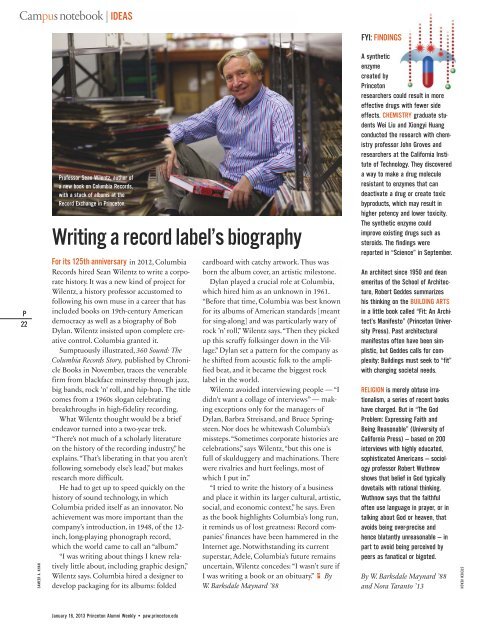Musical machines - Princeton Alumni Weekly - Princeton University
Musical machines - Princeton Alumni Weekly - Princeton University
Musical machines - Princeton Alumni Weekly - Princeton University
Create successful ePaper yourself
Turn your PDF publications into a flip-book with our unique Google optimized e-Paper software.
Campusnotebook | IDEAS<br />
P<br />
22<br />
SAMEER A. KHAN<br />
Professor Sean Wilentz, author of<br />
a new book on Columbia Records,<br />
with a stack of albums at the<br />
Record Exchange in <strong>Princeton</strong>.<br />
Writing a record label’s biography<br />
For its 125th anniversary<br />
in 2012, Columbia<br />
Records hired Sean Wilentz to write a corporate<br />
history. It was a new kind of project for<br />
Wilentz, a history professor accustomed to<br />
following his own muse in a career that has<br />
included books on 19th-century American<br />
democracy as well as a biography of Bob<br />
Dylan. Wilentz insisted upon complete creative<br />
control. Columbia granted it.<br />
Sumptuously illustrated, 360 Sound: The<br />
Columbia Records Story, published by Chronicle<br />
Books in November, traces the venerable<br />
firm from blackface minstrelsy through jazz,<br />
big bands, rock ’n’ roll, and hip-hop. The title<br />
comes from a 1960s slogan celebrating<br />
breakthroughs in high-fidelity recording.<br />
What Wilentz thought would be a brief<br />
endeavor turned into a two-year trek.<br />
“There’s not much of a scholarly literature<br />
on the history of the recording industry,” he<br />
explains. “That’s liberating in that you aren’t<br />
following somebody else’s lead,” but makes<br />
research more difficult.<br />
He had to get up to speed quickly on the<br />
history of sound technology, in which<br />
Columbia prided itself as an innovator. No<br />
achievement was more important than the<br />
company’s introduction, in 1948, of the 12inch,<br />
long-playing phonograph record,<br />
which the world came to call an “album.”<br />
“I was writing about things I knew relatively<br />
little about, including graphic design,”<br />
Wilentz says. Columbia hired a designer to<br />
develop packaging for its albums: folded<br />
January 16, 2013 <strong>Princeton</strong> <strong>Alumni</strong> <strong>Weekly</strong> • paw.princeton.edu<br />
cardboard with catchy artwork. Thus was<br />
born the album cover, an artistic milestone.<br />
Dylan played a crucial role at Columbia,<br />
which hired him as an unknown in 1961.<br />
“Before that time, Columbia was best known<br />
for its albums of American standards [meant<br />
for sing-along] and was particularly wary of<br />
rock ’n’ roll,” Wilentz says. “Then they picked<br />
up this scruffy folksinger down in the Village.”<br />
Dylan set a pattern for the company as<br />
he shifted from acoustic folk to the amplified<br />
beat, and it became the biggest rock<br />
label in the world.<br />
Wilentz avoided interviewing people — “I<br />
didn’t want a collage of interviews” — making<br />
exceptions only for the managers of<br />
Dylan, Barbra Streisand, and Bruce Springsteen.<br />
Nor does he whitewash Columbia’s<br />
missteps. “Sometimes corporate histories are<br />
celebrations,” says Wilentz, “but this one is<br />
full of skulduggery and machinations. There<br />
were rivalries and hurt feelings, most of<br />
which I put in.”<br />
“I tried to write the history of a business<br />
and place it within its larger cultural, artistic,<br />
social, and economic context,” he says. Even<br />
as the book highlights Columbia’s long run,<br />
it reminds us of lost greatness: Record companies’<br />
finances have been hammered in the<br />
Internet age. Notwithstanding its current<br />
superstar, Adele, Columbia’s future remains<br />
uncertain, Wilentz concedes: “I wasn’t sure if<br />
I was writing a book or an obituary.” π By<br />
W. Barksdale Maynard ’88<br />
FYI: FINDINGS<br />
A synthetic<br />
enzyme<br />
created by<br />
<strong>Princeton</strong><br />
researchers could result in more<br />
effective drugs with fewer side<br />
effects. CHEMISTRY graduate students<br />
Wei Liu and Xiongyi Huang<br />
conducted the research with chemistry<br />
professor John Groves and<br />
researchers at the California Institute<br />
of Technology. They discovered<br />
a way to make a drug molecule<br />
resistant to enzymes that can<br />
deactivate a drug or create toxic<br />
byproducts, which may result in<br />
higher potency and lower toxicity.<br />
The synthetic enzyme could<br />
improve existing drugs such as<br />
steroids. The findings were<br />
reported in “Science” in September.<br />
An architect since 1950 and dean<br />
emeritus of the School of Architecture,<br />
Robert Geddes summarizes<br />
his thinking on the BUILDING ARTS<br />
in a little book called “Fit: An Architect’s<br />
Manifesto” (<strong>Princeton</strong> <strong>University</strong><br />
Press). Past architectural<br />
manifestos often have been simplistic,<br />
but Geddes calls for complexity:<br />
Buildings must seek to “fit”<br />
with changing societal needs.<br />
RELIGION is merely obtuse irrationalism,<br />
a series of recent books<br />
have charged. But in “The God<br />
Problem: Expressing Faith and<br />
Being Reasonable” (<strong>University</strong> of<br />
California Press) — based on 200<br />
interviews with highly educated,<br />
sophisticated Americans — sociology<br />
professor Robert Wuthnow<br />
shows that belief in God typically<br />
dovetails with rational thinking.<br />
Wuthnow says that the faithful<br />
often use language in prayer, or in<br />
talking about God or heaven, that<br />
avoids being over-precise and<br />
hence blatantly unreasonable — in<br />
part to avoid being perceived by<br />
peers as fanatical or bigoted.<br />
By W. Barksdale Maynard ’88<br />
and Nora Taranto ’13<br />
STEVEN VEACH


